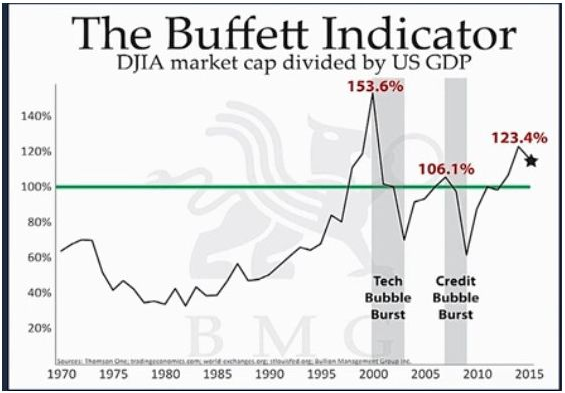Over the past two decades, global markets have taken big hits on three occasions after the ratio broke into triple digits — In 2000, 2008 and again in 2018. . .
Meanwhile, drilling down into the market in the U.S., where stocks are holding up strong in the face of the coronavirus pandemic, shows the indicator is up in all-time record territory.


Known in investing circles as the “Buffett Indicator,” the measure is simply the total market cap of all U.S. stocks relative to the country’s GDP.
> When it’s in the 70% to 80% range, it’s time to throw cash at the market.
> When it moves above 100%, it’s time to lean toward risk-off.

Apply that yardstick worldwide, and, as you can see by this chart from Die Welt market analyst Holger Zschaepitz, a sell signal is flashing.
In fact, the indicator just broke through a 30-month high:
From The Motley Fool :
This indicator climbed to a 30-month high in August. The investing community has been on edge when it comes to high valuations since the beginning of the summer. There are concerns about the diversion between a red-hot market and a still-struggling domestic and global economy.
Investors should never rely on one single indicator to drive their perceptions. However, investors on the hunt for value do have their work cut out for them right now . . ."
Meanwhile, drilling down into the market in the U.S., where stocks are holding up strong in the face of the coronavirus pandemic, shows the indicator is up in all-time record territory.
Warren Buffett said this metric signaled the 2001 crash — now it’s sounding the alarm on global markets
Shawn Langlois
"Warren Buffett once wrote that investors would have seen the dot-com crash coming from a mile away had they paid attention to what he described in a Fortune article in 2001 as “probably the best single measure of where valuations stand at any given moment.”Known in investing circles as the “Buffett Indicator,” the measure is simply the total market cap of all U.S. stocks relative to the country’s GDP.
> When it’s in the 70% to 80% range, it’s time to throw cash at the market.
> When it moves above 100%, it’s time to lean toward risk-off.
Apply that yardstick worldwide, and, as you can see by this chart from Die Welt market analyst Holger Zschaepitz, a sell signal is flashing.
In fact, the indicator just broke through a 30-month high:
Global stock mkts have hit another milestone. All stocks now worth more than 100% of global GDP for the 1st time since 2018, pointing to stretched valuations. For Warren Buffett, a Market Cap to GDP Ratio >100% means stocks in bubble territory. pic.twitter.com/EqPi8A9Tkc
— Holger Zschaepitz (@Schuldensuehner) August 9, 2020.__________________________________________________________________________________
From The Motley Fool :
Warren Buffett: A Market Crash Is Imminent
"Warren Buffett has been unusually quiet in 2020. In July, I’d discussed whether investors should expect a market crash going by his value investing principles. Today, I want to revisit that supposition and look at a market that has continued to experience ballooning valuations into August.Warren Buffett: One model that shows stocks are overpriced
The Buffett indicator takes the combined market capitalizations of publicly traded stocks worldwide and divides it by global gross domestic product. It has been popularized as the favoured indicator of Warren Buffett. If the indicator reads more than 100%, this suggests that the global stock market is overvalued relative to the world economy.This indicator climbed to a 30-month high in August. The investing community has been on edge when it comes to high valuations since the beginning of the summer. There are concerns about the diversion between a red-hot market and a still-struggling domestic and global economy.
Investors should never rely on one single indicator to drive their perceptions. However, investors on the hunt for value do have their work cut out for them right now . . ."

